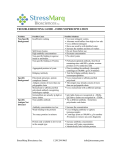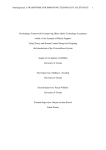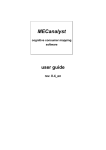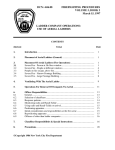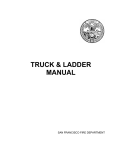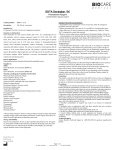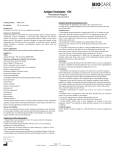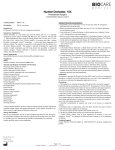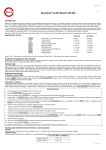Download TROUBLESHOOTING GUIDE – WESTERN BLOT
Transcript
TROUBLESHOOTING GUIDE – WESTERN BLOT Problem Possible Cause Possible Solutions Weak or No Signal Antibody concentrations too low • Increase amount of antibody Primary antibody does not recognize antigen • Check data sheets/references to verify that antibody does detect the antigen in the particular species • Dot blot native and denatured forms, then prove with antibody • HRP should not be used in conjunction with sodium azide or hemoglobin. Thimerosal can be substituted. • Biotinylated antibodies should not be used with milk or casein • Check research/data sheets to make sure the secondary is directed against the host species and isotype of the primary antibody • The antibody has most likely degraded. In the future, it is recommended that aliquots of smaller amounts be made. • The antibody has most likely degraded. Unfortunately a new vial must be used. • Load more protein onto the gel • May be necessary to induce cells before harvest • Use a milder detergent such as Tween-20 Antibody may not recognize a denatured form of the antigen Secondary antibody may be inhibited Inappropriate secondary antibody Constant freezing/thawing can affect antibody Antibody not stored as recommended Protein is undetectable Detergents can disrupt protein binding Too many proteins in sample cause competition Insufficient Development Time Sensitivity issues of detection system Wrong type of membrane StressMarq Biosciences Inc. • Centrifuge lysate to enrich the sample with the protein of interest • Increase development time • Use a more sensitive system- try ECL rather than colorimetric • Use PVDF membranes for a maximum signal. Remember to use more stringent blockers. 1 250 294 9065 [email protected] Problem Possible Cause Possible Solutions Diffuse Background Staining Insufficient Blocking • • • • • Inadequate Washing Contaminated solutions, membrane mishandling, and/or dirty gel plates can lead to spots and streaks • Increase stringency and number of washes • Be aware of potential contaminants- use clean equipment, fresh solutions, wear gloves Incomplete protein reduction causing non-specific bands with a high molecular weight • Use a stronger and more stable reducing agent such as DTT over _mercaptoethanol • Purified protein is more prone to aggregation. A high molecular weight laddering pattern may be showing • Add a sample buffer with protease inhibitor immediately after harvest • Always use fresh samples • Store samples at -70°C or below • Use less protein • Use cell lysate supernatant for nonmembrane bound proteins • Decrease concentration • Decrease staining time Non-Specific Bands Sample degradation causing non-specific bands with low molecular weights Protein overloading Loading whole cell homogenate Antibody concentration too high Over-incubation with secondary antibody enzyme substrate Antibody-antigen cross reactions Additional proteins are being recognized by polyclonal antiserum and causing bands Bands generated by recognition of homologous amino acid sequences Extended incubation periods StressMarq Biosciences Inc. Block overnight Increase amount of blocker Try a different blocker Repeat with a freshly made blocker Are the antibodies in the buffer too? • Determine which bands are being caused by the secondary antibody by probing the membrane • Use a monoclonal or affinity purified antibody • Use a monoclonal antibody specific for a different epitope • One hour should be sufficient for most proteins • Try raising the temperature, rather than increasing the time 1 250 294 9065 [email protected] Problem Possible Cause Possible Solutions Poor Protein Transfer Protein won’t transfer • Use a nylon membrane • Increase field strength • Increase transfer time • Shorten transfer time • Use a double layer of membrane • Use a PVDF membrane Protein transfers through membrane Protein lost from membrane after • Treat with isopropanol for one minute transfer • Allow membrane to completely dry before blocking Protein binding is blocked • Use brand new nitrocellulose sheets • Always wear gloves when handling membranes StressMarq Biosciences Inc. 1 250 294 9065 [email protected]



